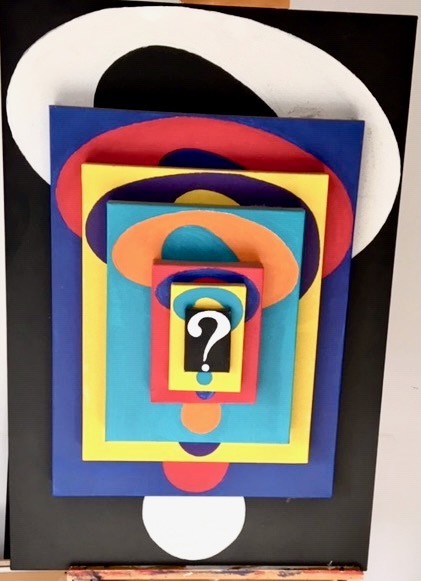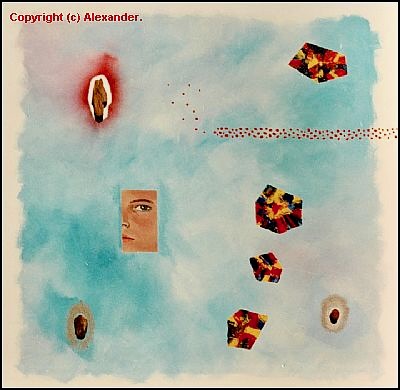By: Douglas Jensen
A Critical Eye on Contemporary Art
It was the summer of 2015 when artist Alexander, after attending a contemporary art expo at the Barker Hanger in Santa Monica, CA, shared his thoughts with art writer and curator Peter Frank. Alexander was deeply disappointed with the exhibition, calling it “a mediocre hodgepodge of historical redundancy.” He believed that the art world had become stagnant, with few artists pushing the boundaries of creativity. For Alexander, innovation had become a rarity, and the industry desperately needed a reinvention.
This sentiment would go on to shape much of his work in the following years as he strived to break free from artistic conventions and explore new realms of creative expression. His passion for expanding artistic possibilities was evident in his words and actions, setting the stage for his most ambitious artistic endeavors.

The Passing of a Reclusive Genius
Alexander, the enigmatic sculptor, painter, and holographic artist, passed away peacefully in his sleep on March 9, 2023. Since his last major solo exhibition in 1993 at the Seoul Art Center Museum, Alexander had largely faded from the public eye. However, despite his reclusiveness, his influence on the art world remained strong. His work had always been ahead of its time, particularly his experimentation with holography, a medium that had captivated him for years.
Though he had not staged a solo exhibition in decades, Alexander continued to participate in various group exhibitions, including some prestigious galleries. Notably, he contributed to the Albermarle Gallery in London, Tufenkian Gallery in Glendale, CA, and the Kavli Gallery at the Bank of America Performing Arts Complex in Thousand Oaks, CA, after 2010. These exhibitions, while not as widely publicized, showcased his continued dedication to pushing the boundaries of art, even in his later years.
A Legacy of Monumental Sculptures
Perhaps the most lasting aspect of Alexander’s legacy is his monumental sculptures, many of which stand in prominent locations across the United States. His artistic vision transformed spaces and challenged conventional perceptions of sculpture. One such work, Uranus and Curved Air, was installed at the Bank of America Performing Arts Center in Thousand Oaks, CA, where it remains an awe-inspiring testament to his ingenuity. Another monumental piece, Oracle in Stone, stands at the entrance to the Brimhall Library in Thousand Oaks, serving as a striking visual marker for those entering the library. Alexander’s piece The Cross was dedicated to Oaks Christian Academy in Westlake, CA, further solidifying his legacy within the community.
These sculptures are not merely physical structures; they are reflections of Alexander’s philosophy about art—timeless, thought-provoking, and groundbreaking. Through these works, he conveyed deep insights into the human experience, challenging viewers to question their relationship with the world around them.

The Post Contemporary Movement
After his disillusionment with the 2015 Barker Hanger exhibit, Alexander took it upon himself to establish a new direction in art. He called this movement “Post Contemporary,” and it represented his desire to move beyond the confines of traditional art forms. For him, this was not just about creating art for art’s sake; it was about forging a new path for future generations of artists. He worked relentlessly to create artworks that were innovative, expanding artistic boundaries in ways that had not been previously imagined.
Over the last decade of his life, Alexander produced more than 350 pieces in his pursuit of Post Contemporary ideals. His works included sculptures, holographic experiments, and immersive, 4-dimensional pieces that would later come to define his late career. His groundbreaking work in holography culminated in what many consider his most remarkable achievement: the world’s first holographic movie viewable without the need for special glasses. This revolutionary development in the field of visual art has left a lasting mark on both the art and technology communities.

The Alexander Retrospective at VEFA Gallery
To honor Alexander’s incredible contributions to the world of contemporary art, a major retrospective is being held at the VEFA Gallery, located at 21825 Hawthorne Blvd., Torrance, CA. This 7,000-square-foot gallery will showcase a diverse range of his works, including holographic art, 4-dimensional sculptures, holo-paintings, and his groundbreaking holographic movie. The retrospective is set to highlight the full spectrum of Alexander’s artistic journey, offering a unique opportunity to witness his visionary approach to art.
The VEFA Gallery, built and managed by the Dr. Joseph and Katherine Anderson Family, will provide a fitting venue for this celebration of Alexander’s life and work. Jonathan Anderson, the gallery director, along with Susie Paine, the director of events, have been instrumental in organizing this exhibition. The retrospective promises to be a once-in-a-lifetime event for art lovers and collectors alike.
For more details on the Alexander Retrospective and other upcoming events, visit the VEFA Gallery website at www.vefagallery.com or www.alexander-art.net.
Through this retrospective, Alexander’s legacy will continue to inspire, challenging artists and art lovers.
Published by Jeremy S.

















